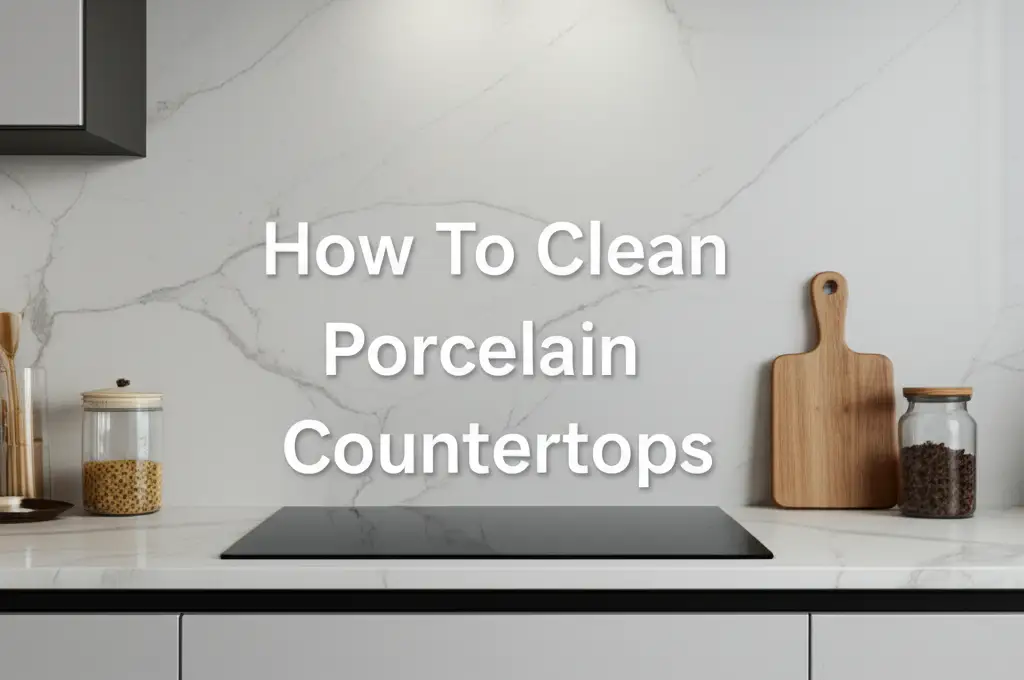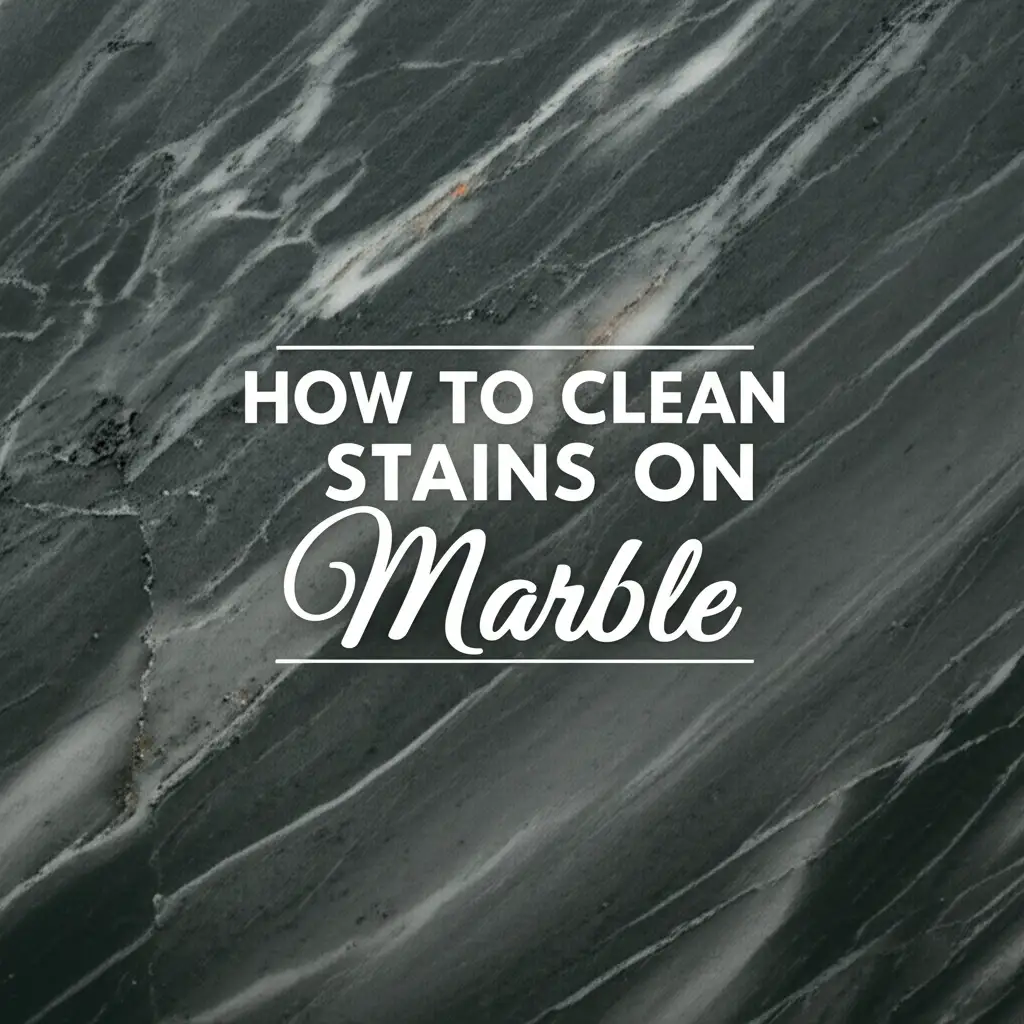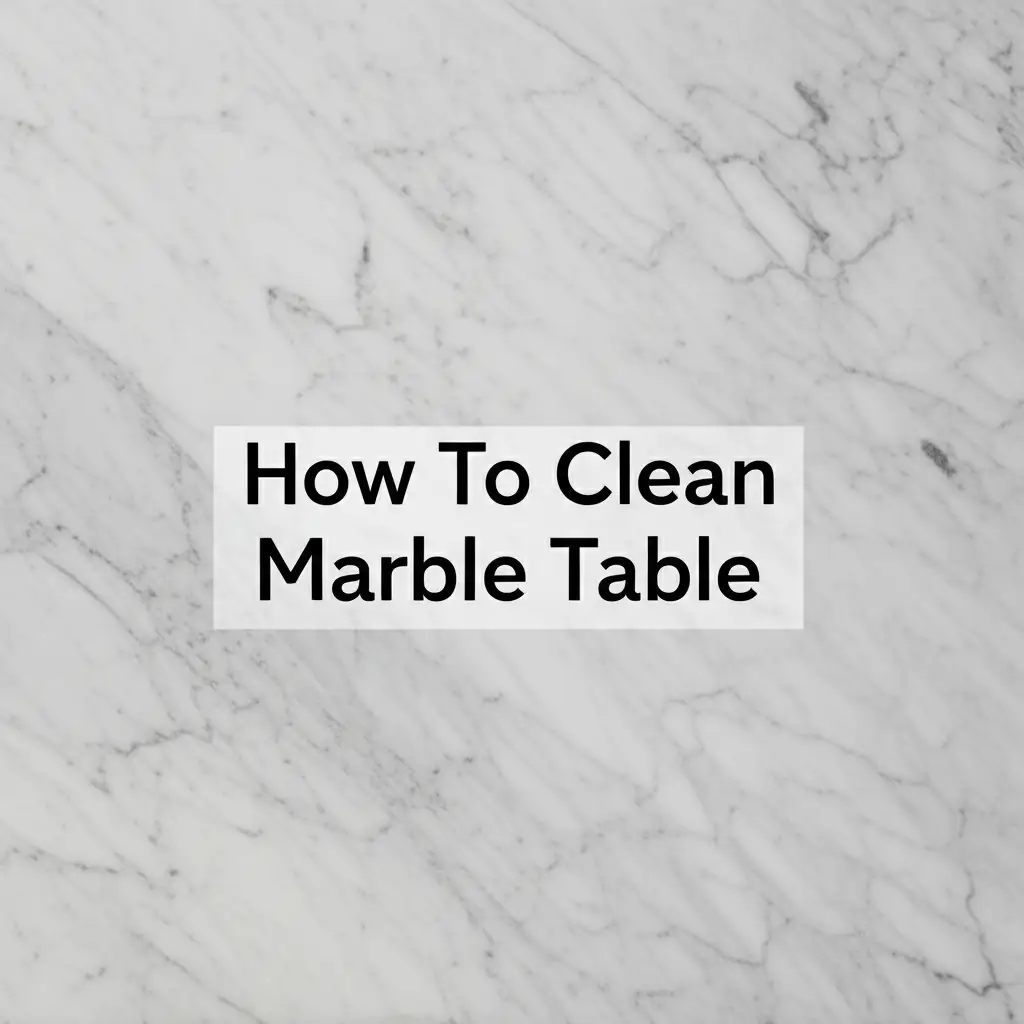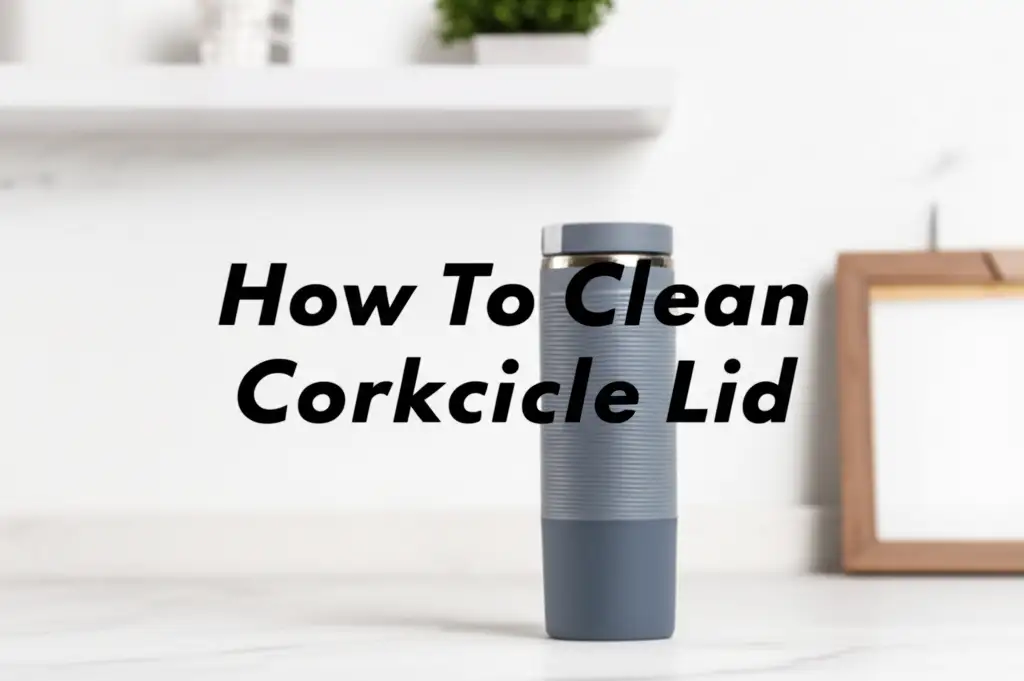· Home Care · 14 min read
How To Clean Porcelain Countertops

How to Clean Porcelain Countertops: Your Complete Guide
Porcelain countertops offer beauty and strength to any kitchen or bathroom. They resist scratches, heat, and many stains. People choose them for their sleek look and practical benefits. Keeping these surfaces clean ensures they remain beautiful for many years. Knowing how to clean porcelain countertops correctly stops damage. It also keeps them looking new. This article explains how to care for your porcelain surfaces. We will cover daily cleaning, stain removal, and deep cleaning methods. You will learn the best products and techniques. This guide helps you keep your countertops spotless.
Takeaway:
- Clean porcelain countertops daily with mild soap and water.
- Address spills and fresh stains immediately to prevent setting.
- Use specific methods and gentle cleaners for stubborn stains.
- Avoid abrasive tools or harsh chemicals that can damage the surface.
- Regular deep cleaning and proper care extend the life of your countertops.
How do you effectively clean porcelain countertops? Effectively cleaning porcelain countertops involves daily wiping with a soft cloth, warm water, and a pH-neutral cleaner. For spills, immediate action prevents stains. Stubborn marks may need specific gentle cleaning agents like baking soda paste or hydrogen peroxide. Always rinse surfaces thoroughly after cleaning to remove all residue.
Understanding Your Porcelain Countertops
Porcelain countertops are engineered surfaces. They consist of clay minerals fired at very high temperatures. This process makes them extremely dense and non-porous. This density is why they resist many types of damage. They are different from other countertop materials. For example, how to clean granite countertops stains involves different considerations due to granite’s natural porosity. Porcelain surfaces do not require sealing like natural stone. This makes them easier to maintain. Their tough surface resists scratches from daily use.
Porcelain also handles heat well. You can place hot pots on them without worry. This quality makes them practical for busy kitchens. They are also resistant to UV light. This means their color will not fade over time. These properties make porcelain a favored choice for modern homes. Understanding these qualities helps you clean porcelain countertops correctly. It ensures you use the right cleaning methods for this durable material.
Daily Cleaning for Porcelain Countertops
Daily cleaning keeps your porcelain countertops looking their best. This routine is simple and quick. It prevents dirt and food particles from building up. I always start my day by wiping down my kitchen surfaces. This simple step helps keep my home tidy. You will need only a few basic supplies for this task.
First, gather a soft microfiber cloth or sponge. Next, prepare a bowl of warm water. Add a few drops of mild dish soap to the water. This creates a gentle cleaning solution. Dip your cloth into the soapy water. Wring out excess liquid. You want the cloth damp, not soaking wet. Wipe down the entire countertop surface. Pay attention to areas where food prep occurs. Rinse the cloth often to remove dirt. After wiping with the soapy cloth, use a clean, damp cloth. Wipe the surface again to remove all soap residue. Finish by drying the countertop with a dry, clean cloth. This step prevents water spots. Daily cleaning prevents stains and keeps your porcelain bright. It is the first step in effective porcelain countertop care.
Dealing with Spills and Fresh Stains
Spills happen quickly in a busy kitchen. Immediate action is critical for porcelain countertops. Porcelain is highly stain-resistant. However, some acidic or highly pigmented liquids can still leave a mark if left to sit. I learned this firsthand after a red wine spill. Act fast to protect your surfaces.
When a spill occurs, blot it immediately with a clean cloth. Do not wipe or spread the spill. Blotting lifts the liquid from the surface. For sticky spills, a damp cloth works best. After blotting the initial liquid, spray a mild all-purpose cleaner on the spot. Wipe it clean with a soft cloth. Rinse the area with clean water. Dry it thoroughly to prevent streaks. For common kitchen culprits like coffee or tea, follow the same steps. If a slight discoloration remains, make a paste. Mix a small amount of baking soda with water. Apply this paste to the stain. Let it sit for a few minutes. Then gently scrub with a soft brush or sponge. Rinse well and dry. Fast response minimizes any potential damage. This quick action is key to keeping porcelain countertops pristine.
Removing Stubborn Stains from Porcelain Countertops
Some stains cling to porcelain despite daily cleaning. These stubborn marks require a bit more effort. Do not worry; porcelain is durable. You can tackle most tough stains effectively. Always start with the gentlest method first. Then, move to stronger solutions if needed.
For ink or marker stains, rubbing alcohol often works wonders. Apply a small amount to a clean cloth. Gently rub the stained area. Rinse with water. For rust marks, a commercial rust remover designed for non-porous surfaces helps. Make sure it is safe for porcelain. Some iron-rich water can leave rust. How to clean a stained porcelain sink often involves similar techniques for rust. Mineral deposits, like hard water spots, respond well to white vinegar. Mix equal parts white vinegar and water. Spray this solution on the deposits. Let it sit for 5-10 minutes. Then scrub with a non-abrasive pad. Rinse completely. For deeply colored food stains, like turmeric or beet juice, hydrogen peroxide can be effective. Pour a small amount directly onto the stain. Let it sit for 10-15 minutes. Use a paper towel to absorb the liquid. Rinse and dry the surface. Always test new cleaners in a hidden spot first. This checks for any adverse reactions. Taking these steps helps restore your porcelain’s clean look.
Deep Cleaning Porcelain Countertops
Deep cleaning is an important part of countertop maintenance. It removes grime and residues that build up over time. I deep clean my kitchen porcelain countertops every few months. This process brings back their original luster. It also maintains hygiene. A thorough deep clean ensures your surfaces stay sanitary.
Start by clearing everything off your countertops. This gives you full access to the surface. Next, prepare a cleaning solution. You can use a commercial cleaner made for porcelain. Or, make your own with warm water and a bit of dish soap. For an extra boost, add a quarter cup of white vinegar. Spray the entire countertop surface with your chosen cleaner. Let it sit for 5-10 minutes. This dwell time allows the solution to break down dirt. Use a soft scrub brush or sponge to gently scrub the surface. Pay extra attention to corners and edges. These spots often collect more grime. For grout lines, a small scrub brush can help. Rinse the entire surface thoroughly with clean water. Use a clean cloth to wipe away all cleaning solution. Finish by drying the countertops with a dry microfiber cloth. This prevents water spots and streaks. Regular deep cleaning keeps your porcelain looking fresh. It extends the life of your beautiful surfaces.
Protecting Your Porcelain Countertops: Do’s and Don’ts
Protecting your porcelain countertops helps them last longer. Knowing what to do and what to avoid is simple. I make sure my family follows these guidelines. This keeps our surfaces looking great. Proper care prevents common problems.
Do’s:
- Do use cutting boards: Always place a cutting board on your countertop when chopping or slicing food. While porcelain resists scratches, a sharp knife can still leave a mark. This also protects your knives.
- Do clean up spills immediately: As discussed, quick action on spills prevents stains from setting. Porcelain is non-porous, but fast cleanup is best practice.
- Do use trivets for hot pans: Though porcelain is heat-resistant, extreme temperature changes can cause thermal shock. A trivet adds an extra layer of protection.
- Do use pH-neutral cleaners: Stick to mild soaps and specific porcelain cleaners. These products clean effectively without damaging the surface.
- Do wipe regularly: A quick daily wipe keeps dust and minor debris from accumulating. This also cuts down on deep cleaning frequency.
Don’ts:
- Don’t use abrasive cleaners: Scouring powders, steel wool, or harsh scrubbing pads can scratch the surface. They may dull the finish over time.
- Don’t use highly acidic or alkaline cleaners: Bleach, oven cleaners, drain cleaners, or strong industrial chemicals can damage the surface finish. These types of cleaners are also bad for other surfaces, such as those covered in how to clean wood countertops.
- Don’t drag heavy objects: Lift heavy pots, appliances, or decorative items instead of dragging them. This prevents accidental scratches or chips.
- Don’t ignore stains: Even if porcelain is resistant, some dyes or strong chemicals can etch the surface if left for long periods.
- Don’t use wax-based cleaners or sealants: Porcelain is non-porous and does not need sealing. Wax-based products can leave a dull film or sticky residue.
- Don’t use cleaners with dyes: Some colored cleaners can leave a tint on light-colored porcelain surfaces. Stick to clear or natural solutions.
Following these simple rules preserves the beauty of your porcelain. It ensures your investment lasts for many years.
Common Cleaning Mistakes to Avoid
Making mistakes when cleaning can harm your porcelain countertops. I have seen common errors cause unnecessary damage. Knowing what to avoid saves you time and money. It protects your beautiful surfaces. Here are pitfalls to bypass.
First, do not use abrasive scrubbing pads or steel wool. These tools are too rough for porcelain. They can leave tiny scratches. Over time, these scratches make your countertop look dull. Instead, always choose a soft cloth or a non-abrasive sponge.
Second, avoid harsh chemical cleaners. This includes bleach, ammonia-based cleaners, and oven cleaners. These strong chemicals can break down the finish of your porcelain. They may cause discoloration or etching. Always read product labels carefully. Look for cleaners specified as safe for porcelain. Similarly, when learning how to clean concrete countertops, gentle cleaners are also recommended.
Third, never let spills sit. Even if porcelain resists stains, prolonged contact with certain liquids can cause problems. Acidic foods like lemon juice or tomato sauce can etch the surface. Highly pigmented liquids like red wine can leave a shadow if not wiped quickly. Make cleaning spills an immediate task.
Fourth, do not forget to rinse and dry. Leaving cleaning solution residue on your countertop can lead to dullness or a sticky film. Always wipe down the surface with clean water. Then dry it completely with a clean, dry cloth. This step prevents water spots and streaks. Proper rinsing and drying ensure a sparkling finish. Avoiding these common mistakes keeps your porcelain countertops looking perfect.
Recommended Tools and Products for Porcelain Countertops
Choosing the right tools and products makes cleaning porcelain easy. You do not need a lot of specialized items. I use simple, effective supplies for my daily routine. Having these items on hand prepares you for any cleaning task.
For everyday cleaning, a soft microfiber cloth is essential. These cloths are gentle on surfaces. They absorb liquids well. They also pick up dirt without leaving streaks. I keep several clean microfiber cloths in my kitchen. A soft sponge is also useful for light scrubbing. Make sure it is not abrasive.
For cleaning solutions, mild dish soap diluted in warm water is your best friend. It cuts through grease and grime gently. Choose a pH-neutral formula. Many brands offer gentle dish soaps. An all-purpose cleaner specified as safe for porcelain is another good option. Read the label carefully to ensure it is non-abrasive and pH-neutral. Many household cleaners can be too strong.
For tougher stains, baking soda is a safe, natural abrasive. Mix it with a little water to form a paste. Hydrogen peroxide works well for organic stains and brightening. Always test it in an inconspicuous area first. White vinegar diluted with water is excellent for hard water spots. However, use it sparingly and rinse well, as it is acidic. For specialized issues like rust, a rust remover for porcelain is needed. Make sure it is formulated for delicate surfaces.
Avoid abrasive brushes, steel wool, or harsh chemical sprays. Stick to these recommended tools and products. They will keep your porcelain countertops beautiful and protected.
Restoring Shine to Porcelain Countertops
Porcelain countertops can lose their sparkle over time. This often happens due to cleaning product residue. It can also be from hard water spots. Restoring their shine is easy. It makes your kitchen look brighter. I follow a simple process to bring back the luster.
First, identify the cause of the dullness. Is it a film from soap? Are there mineral deposits from water? Knowing the problem helps you choose the right solution. If it is soap residue, a thorough rinse is usually enough. Use a clean cloth and warm water. Wipe the entire surface. Rinse the cloth often. Then, dry it completely with a separate, dry microfiber cloth. This removes the film.
For hard water spots or mineral buildup, white vinegar is effective. Mix equal parts white vinegar and water in a spray bottle. Spray the affected areas. Let the solution sit for about 5 to 10 minutes. The acidity in the vinegar helps dissolve the mineral deposits. Use a soft, non-abrasive sponge to gently scrub. Work in small circular motions. After scrubbing, rinse the area thoroughly with clean water. Dry the surface completely with a dry cloth. This prevents new water spots.
If dullness persists, it might be due to micro-scratches from improper cleaning. In this case, consult a professional. They may have specialized polishing compounds for porcelain. However, these are rarely needed with proper care. Regular cleaning with mild products prevents dullness. It keeps your porcelain countertops shining like new.
Frequently Asked Questions
What is the best daily cleaner for porcelain countertops?
The best daily cleaner for porcelain countertops is warm water mixed with a few drops of mild dish soap. This gentle solution effectively removes spills and grime without harming the surface. Always use a soft microfiber cloth for application. Rinse the surface well and dry it to prevent water spots and keep the shine.
Can I use bleach on porcelain countertops?
No, you should not use bleach on porcelain countertops regularly. While porcelain is highly resistant, bleach is a harsh chemical that can dull the finish over time. It may also leave a residue. For tough stains, try gentler alternatives first. Use bleach only as a last resort for very stubborn stains, in a diluted form, and rinse thoroughly.
Do porcelain countertops stain easily?
No, porcelain countertops do not stain easily. They are highly non-porous. This property makes them naturally resistant to most common stains. Promptly wiping up spills is still the best practice. Some highly acidic or deeply colored liquids can leave marks if left for a long time.
How do I remove hard water spots from porcelain?
Remove hard water spots from porcelain by using a solution of equal parts white vinegar and water. Spray the solution on the spots. Let it sit for 5-10 minutes. The vinegar helps dissolve the mineral buildup. Then, gently scrub with a soft, non-abrasive sponge. Rinse thoroughly and dry the surface completely.
Are porcelain countertops scratch-resistant?
Yes, porcelain countertops are highly scratch-resistant. They are very hard and dense. This makes them more resistant to scratches than many other countertop materials. However, using a cutting board is still recommended. Extreme force or very sharp ceramic knives can still potentially mark the surface.
Do porcelain countertops need to be sealed?
No, porcelain countertops do not need to be sealed. Their manufacturing process creates a naturally non-porous surface. This means liquids and bacteria cannot penetrate the material. This inherent non-porosity is a key advantage. It simplifies maintenance compared to natural stone countertops, which often require sealing.
Conclusion
Keeping your porcelain countertops clean is a simple process. It guarantees their lasting beauty and function. We covered daily care, quick spill responses, and effective stain removal techniques. You learned the importance of gentle products and avoiding harsh chemicals. Remember, porcelain’s non-porous nature makes it easy to maintain. A little consistent effort goes a long way.
By following these simple guidelines, your porcelain surfaces will remain a highlight of your home. They will stay sparkling and hygienic for many years. Regular cleaning and attention to detail ensure your investment looks its best. Start today and give your porcelain countertops the care they deserve. Your kitchen will thank you.
- porcelain countertops
- countertop cleaning
- stain removal
- kitchen cleaning




